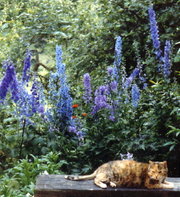Delphinium
|
|
| Delphinium | ||||||||||||
|---|---|---|---|---|---|---|---|---|---|---|---|---|
| Missing image Delphinium_elatum_1.jpg Delphinium elatum in flower, Nockberge, Kärnten, Austria | ||||||||||||
| Scientific classification | ||||||||||||
| ||||||||||||
| Species | ||||||||||||
|
About 250 species, including: |
Delphinium is a genus of about 250 species of annual, biennial or perennial flowering plants in the buttercup family Ranunculaceae, native throughout the Northern Hemisphere and also on the high mountains of tropical Africa. The common name, shared with the closely related genus Consolida, is Larkspur.
Larkspur_in_Utah.jpg
The leaves are deeply lobed with 3-7 toothed, pointed lobes. The main flowering stem is erect, and varies greatly in size between the species, from 10 cm in some alpine species, up to 2 m tall in the larger meadowland species; it is topped by many flowers, varying between purple, blue, red, yellow or white. The flower has five petals which grow together together to form a hollow flower with a spur at the end, which gives the plant its name. The seeds are small and shiny black. The plants flower from late spring to late summer, and are pollinated by butterflies and bumble bees.
Other names are, lark's heel (Shakespeare), lark's claw and knight's spur. The scientific name is taken from Dioscorides and describes the shape of the bud, which is thought to look like a (rather fat) dolphin.
The Forking Larkspur (Delphinium consolida) prefers chalky loams. It grows wild in cornfields, but has become very rare nowadays. The flowers are commonly purple, but a white variety exists as well.
Baker's larkspur (Delphinium bakeri) and Yellow larkspur (D. luteum), both native to very restricted areas of California, are highly endangered species.
Cultivation and uses
Many species are cultivated as garden plants, with numerous cultivars having been selected for their denser, more prominent flowers.
All parts of the plant contain an alkaloid Delphinin and are very poisonous, causing vomiting when eaten, and death in larger amounts. In small amounts, extracts of the plant have been used in herbal medicine. Gerard's herball reports that drinking the seed of larkspur was thought to help against the stings of scorpions, and that other poisonous animals could not move when covered by the herb, but does not believe it himself. Grieve's herbal reports that the seeds can be used against parasites, especially lice and their nits in the hair. A tincture is used against asthma and dropsy. The juice of the flowers, mixed with alum, gives a blue ink.
The plant was connected to Saint Odile and in popular medicine used against eye-diseases. It was one of the herbs used on the feast of St. John and us such warded against lightning. In Transsylvania, it was used to keep witches from the stables, probably because of its blue color.de:Rittersporne it:Delphinium lt:Pentinius

